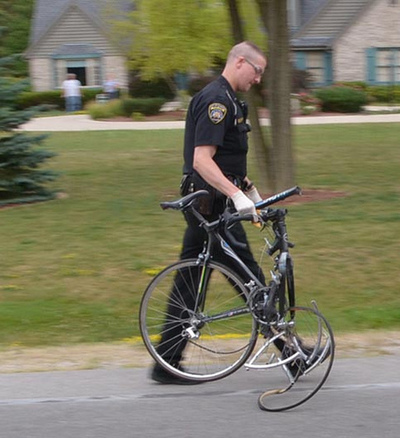Cyclists more often get the blame if they die in a crash
Over 100 Washington area cyclists have died in motor vehicle crashes since 1987. Previously, I mapped out their locations. What about the outcomes? Police fault cyclists and drivers equally, except in Prince George’s County, where they overwhelmingly blame cyclists.
Cyclists are found at fault more than drivers
I collected data on fatal crashes involving both a cyclist and a driver in the region since 1987. The data came from media reports and the National Highway Traffic Safety Administration’s Fatality Analysis Reporting System (FARS).
I was able to determine who was found at fault in 83% of the crashes. Cyclists got the blame 58.9% of the time. This could be because cyclists are just more reckless than drivers, but it could also be that there is a failure in the reporting itself.
There’s a big discrepancy between the two sources. Of all of the cases in which fault was assigned, 34.4% relied only on data from a FARS report. In these cases, cyclists got the blame 74.1% of the time. In contrast, where the details of the crash came from a media report or from both a media report and a FARS report, cyclists only got the blame in 30 out of 59 crashes, or 50.8% of the time.
Prince George’s finds cyclists at fault far more often
Prince George’s County has has the most bike fatalities of any jurisdiction in the area. It’s also the place cyclists are most often found at fault.
Cyclists got the blame in 76.7% of Prince George’s fatal crashes, compared to 52.9% in Northern Virginia, 50% in Montgomery County, and 48% in DC. In fact, outside Prince George’s County, drivers and cyclists in the region share fault 50-50.
Could police bias explain these discrepancies?
Responding police officers are responsible for filling out FARS reports, so police bias might be a factor.
For example, in several cases the only contributing factor was “Walking/Riding With Or Against Traffic, Playing, Working, Sitting, Lying, Standing, Etc. In Roadway.” This could mean a lot of things, including something as simple as the cyclist riding in the road.
The inherently one-sided interview can also play a role. Often the only living witness, the driver, has a strong incentive to blame the cyclist, and perhaps the police do not do enough to challenge these claims.
On the other side of things, it’s possible that the media only reported on crashes where the driver was to blame. My data set has far more news stories on the investigation, subsequent trial, and verdict when the driver was criminally at fault. Perhaps stories where the driver is at fault, such as the recent fatal crash near Baltimore, are more appealing to the media.
In addition to asking why the county is so deadly for cyclists, Prince George’s County needs to ask the question of why cyclists who die there are so much more likely to be blamed. Are Prince George’s cyclists worse? Do the roads there invite risky cycling? Is there a difference in the way police and journalists investigate and report crashes in Prince George’s?
If it’s bias, someone needs to address it for the sake of both justice and safety. If it’s cyclists riding dangerously, then the county needs more education and enforcement. If it’s road design, the county needs to change the roads. Being such a negative outlier should be cause for alarm.

